The Life of Oharu Blu-ray Movie
HomeThe Life of Oharu Blu-ray Movie 
西鶴一代女 / Saikaku ichidai onnaCriterion | 1952 | 137 min | Not rated | Jul 09, 2013
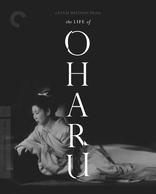
Movie rating
8.1 | / 10 |
Blu-ray rating
| Users | 0.0 | |
| Reviewer | 4.0 | |
| Overall | 4.0 |
Overview
The Life of Oharu (1952)
An imperial lady-in-waiting gradually descends to street prostitution.
Starring: Toshirô Mifune, Kinuyo Tanaka, Hisako Yamane, Jûkichi Uno, Ichirô SugaiDirector: Kenji Mizoguchi
| Foreign | 100% |
| Drama | 77% |
Specifications
Video
Video codec: MPEG-4 AVC
Video resolution: 1080p
Aspect ratio: 1.37:1
Original aspect ratio: 1.37:1
Audio
Japanese: LPCM Mono (48kHz, 24-bit)
Subtitles
English
Discs
50GB Blu-ray Disc
Single disc (1 BD)
Playback
Region A (locked)
Review
Rating summary
| Movie | 4.5 | |
| Video | 4.0 | |
| Audio | 4.0 | |
| Extras | 3.5 | |
| Overall | 4.0 |
The Life of Oharu Blu-ray Movie Review
Reviewed by Dr. Svet Atanasov June 22, 2013Japanese director Kenji Mizoguchi's "Saikaku ichidai onna" a.k.a "The Life of Oharu" (1952) arrives on Blu-ray courtesy of Criterion. The supplemental features on the disc include new audio essay by film scholar Dudley Andrew; audio commentary by Dudley Andrew; and a documentary film directed by Koko Kajiyama. The release also arrives with an illustrated booklet featuring an essay by film scholar Gilberto Perez. In Japanese, with optional English subtitles for the main feature. Region-A "locked".
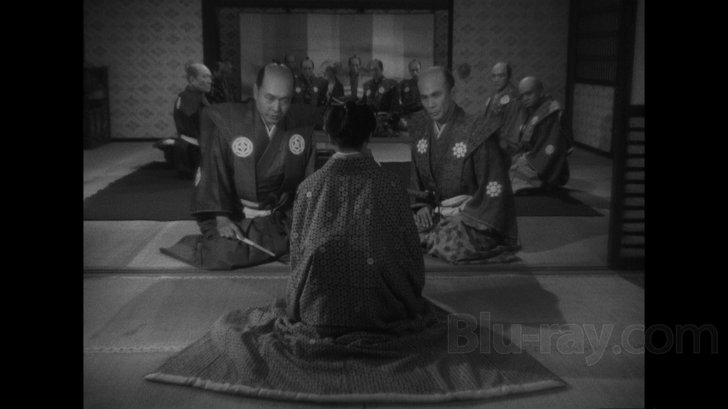
"You must spend day and night repenting for your sins..."
The film opens up on the cold streets of 17th century Kyoto where a group of prostitutes gather around a large fire to warm up. One of them is Oharu (Kinuyo Tanaka, The Ballad of Narayama, Sansho the Bailiff), an aging beauty who years ago fell in love with a low ranking page (Toshiro Mifune, Yojimbo, Sanjuro). When one of the prostitutes asks Oharu how she ended up on the streets, a series of flashbacks reveal her story.
Some years earlier.
Oharu’s affair with Katsunosuke is discovered and the young man is quickly sentenced to death. Before he is beheaded, Katsunosuke urges Oharu to marry only when she finds a man whom she truly loves. Then the disgraced lady-in-waiting and her family are also sentenced to exile.
Soon after, Oharu attempts to commit suicide. Barely able to contain his anger, her father (Ichiro Sugai, Early Summer) sells her to the powerful Lord Matsudaira (Toshiaki Konoe, Gate of Hell), who desperately needs a healthy concubine that will bear him a son. After she does, Lord Matsudaira's wife sends Oharu back to her parents. Convinced that Oharu has disgraced her family yet again, her father quickly sells her to the owner of a popular local brothel where she becomes a geisha. With the money Oharu earns, her father pays off his debts.
In the brothel, Oharu meets Yakichi (Jukichi Uno, Onibaba), an honest fan maker who seems like the type of man she could create a family with. Oharu marries Yakuchi, but shortly after that he is killed. Emotionally devastated and unable to find employment, Oharu ends up alone on the streets of Kyoto where she attempts to get drunks and older men to sleep with her for money.
Based on Saikaku Ihara’s novel The Life of an Amorous Woman, Kenji Mizoguchi’s The Life of Oharu is one quite unusual emotional roller-coaster of a film. Even by Western standards, the often harsh tone and directness of the film can be quite surprising.
Mizoguchi apparently came up with the idea for the film while shooting Utamaro and His Five Women, one of the Japanese director’s most autobiographical works, but The Life of Oharu actually has plenty in common with his Osaka Elegy. One of Mizoguchi’s most angry and most direct films, Osaka Elegy also chronicles the life of a young woman who is rejected by her family after she compromises herself. Like Oharu, she attempts to rebalance her life in a society dominated by men, but quickly realizes that for women like her there are no second chances in life.
The Life of Oharu is the bleaker of the two films. Oharu is repeatedly abused and exploited by men whose authority simply cannot be questioned and her life quickly becomes a living hell. Even when she turns to religion to find solace, her downfall continues. In Osaka Elegy, at least for a short period of time the young woman’s wealthy lovers give her a reason to believe that life is worth living.
Tanaka and Mizoguchi were a formidable duo. Despite the many emotional ups and downs in the life of Tanaka’s character, there isn’t a single sequence in the film that feels overly melodramatic.
The Life of Oharu was the second Japanese film to win a major award at the Venice Film Festival. (The first was Akira Kurosawa’s Rashômon). In 1952, The Life of Oharu won the festival’s International Award. (The other two films that won the award during the same year were John Ford’s The Quiet Man and Roberto Rossellini’s The Greatest Love a.k.a Europe '51).
The Life of Oharu Blu-ray Movie, Video Quality 
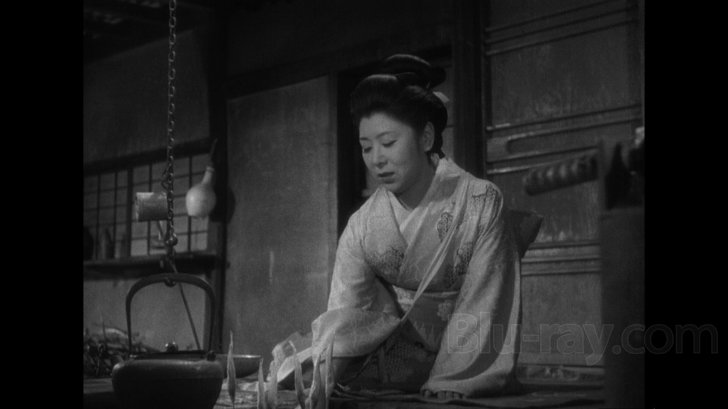
Presented in its original aspect ratio of 1.37:1, encoded with MPEG-4 AVC and granted a 1080p transfer, Kenji Mizoguchi's Life of Oharu arrives on Blu-ray courtesy of Criterion.
The following text appears inside the booklet provided with this Blu-ray release:
"This new high-definition digital transfer was created on a Spirit Datacine from a 35mm fine-grain master positive struck from the original camera negative, except for reel one, which was taken from a 35mm duplicate negative, because that portion of the master positive has been lost. The restoration was supervised by the Prasad Group, India, and the Criterion Collection.
The original monaural soundtrack was remastered at 24-bit from the fine-grain optical track. Clicks, thumps, hiss, and hum were manually removed using Pro Tool HD. Crackle was attenuated using AudioCube's integrated workstation.
Transfer supervisor: Lee Kline.
Colorist: Yoshiaki Abe/Imagica, Tokyo; Lee Kline."
Traces of some minor wear around the edges are at times visible. A few extremely light vertical lines also pop up. There are also a couple of frame skips and and very light warps. It is easy to tell, however, that the film has been carefully cleaned up as it actually looks very healthy (take a look at the films in The Mizoguchi Collection to see how much more fragile some of Japanese director's films could look). Where possible, various stabilizations have been done as well. Most of the close-ups convey quite pleasing depth, especially the ones with plenty of light (see screencapture #8). The panoramic vistas also boast good clarity and fluidity (see screencapture #3). Color saturation is also very good, with the blacks and whites never looking artificially boosted. There are no traces of excessive degraining corrections. Sharpening adjustments have not been performed either. Finally, serious transfer specific anomalies such as aliasing, banding, and flicker do not plague the high-definition transfer. To sum it all up, there are some inherited source limitations, but this is a solid organic presentation of a film which I believe at this point looks as good as it can. (Note: This is a Region-A "locked" Blu-ray disc. Therefore, you must have a native Region-A or Region-Free PS3 or SA in order to access its content).
The Life of Oharu Blu-ray Movie, Audio Quality 
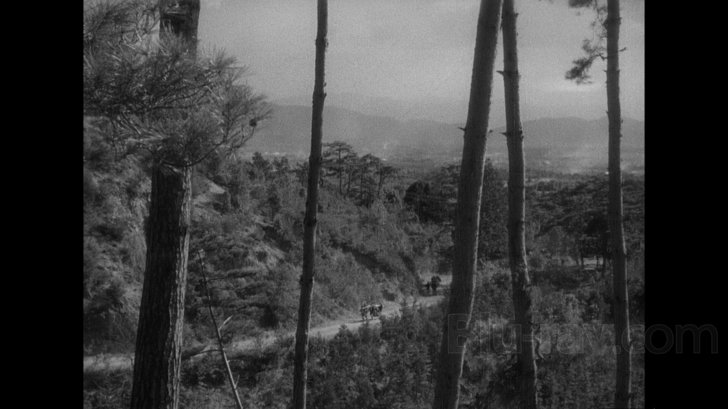
There is only one standard audio track on this Blu-ray release: Japanese LPCM 1.0. For the record, Criterion have provided optional English subtitles for the main feature.
There are no serious dynamic fluctuations, dropouts, or distortions. Overall dynamic intensity is quite limited, but this should not be surprising considering the age and history of Life of Oharu. Generally speaking, the sound is well balanced, clean, and stable (this isn't always the case with the four films in The Mizoguchi Collection). The English translation is very good.
The Life of Oharu Blu-ray Movie, Special Features and Extras 
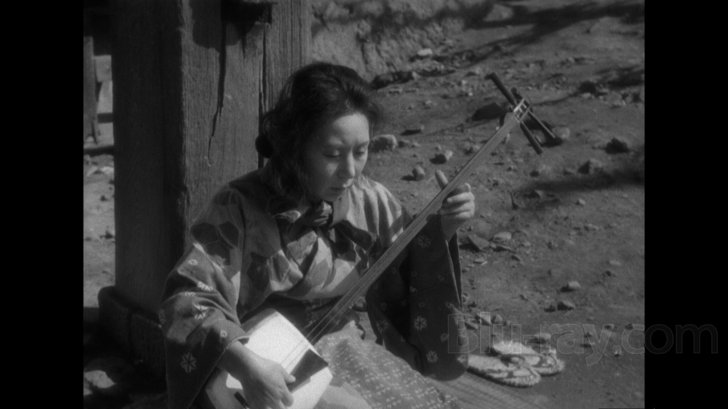
- Dudley Andrew on The Life of Oharu -
1. Mizoguchi's Art and the Demimonde - in this audio essay, film scholar Dudley Andrew discusses director Kenji Mizoguchi's life and career, the roles women have in his film, his interest in art, etc. Mr. Andrew also discusses Saikaku Ihara's novel The Life of an Amorous Woman and relationship between the Japanese director's Utamaro and His Five Women and The Life of Oharu. The essay was written in 2013. In English, not subtitled. (19 min, 1080p).
2. Audio commentary by film scholar Dudley Andrew which plays over the first twenty eight minutes of The Life of Oharu. The majority of the information here pertains to the unique relationship between Kinuyo Tanaka and Kenji Mizoguchi and the important themes in The Life of Oharu. In English, not subtitled.
- The Travels of Kinuyo Tanaka - a very informative documentary film directed by Koko Kajiyama focusing on the rocky career of actress Kinuyo Tanaka. The film contains a large amount archival footage, photos, and extracts from newspaper articles. It was produced in association with Geiyu-kai and was screened as part of an exhibition at the National Film Center in Tokyo in 2009. In Japanese, with optional English subtitles. (32 min, 1080i).
- Booklet - an illustrated booklet featuring an essay by film scholar Gilberto Perez.
The Life of Oharu Blu-ray Movie, Overall Score and Recommendation 
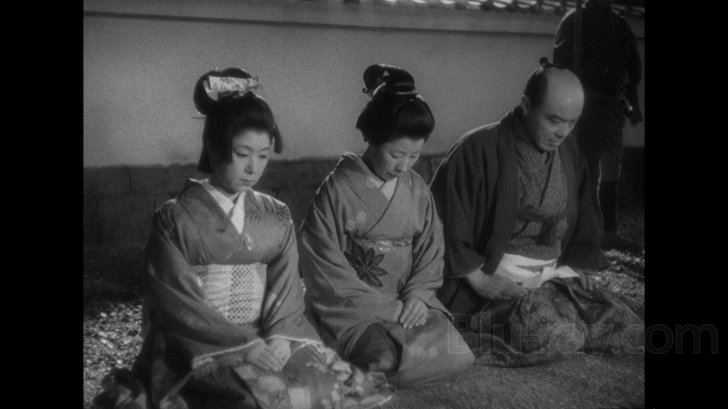
I think that it is fantastic to see that Kenji Mizoguchi's films are slowly making their way to Blu-ray. The Life of Oharu, one of the Japanese master's best films, now looks quite wonderful, and I cannot recommend it highly-enough to anyone interested in classic Japanese cinema. I would also like to encourage you to consider adding to your collections The Mizoguchi Collection, which contains four Mizoguchi's films, including the terrific Utamaro and His Five Women and Osaka Elegy, that are no currently available on Blu-ray in North America. HIGHLY RECOMMENDED.
Similar titles
Similar titles you might also like

Sansho the Bailiff
山椒大夫 / Sanshô dayû
1954

A Brighter Summer Day
牯嶺街少年殺人事件
1991

Tokyo Story
東京物語
1953

Yi Yi
一一
2000

Harakiri
切腹 / Seppuku
1962

Ugetsu
雨月物語 / Ugetsu monogatari
1953

An Autumn Afternoon
秋刀魚の味
1962

L' Avventura
1960

Late Spring
晩春
1949

The Marriage of Maria Braun
Die Ehe der Maria Braun
1978

Jeanne Dielman, 23, quai du Commerce, 1080 Bruxelles
1975

The Story of the Last Chrysanthemum
残菊物語 / Zangiku monogatari
1939

Belle de jour
1967

Wild Strawberries
Smultronstället
1957

Early Summer
麥秋
1951

Zama
2017

24 Frames
2017

Onibaba
鬼婆
1964

Elles
2011

Mamma Roma
1962